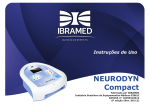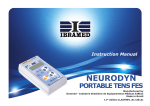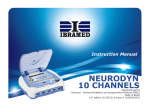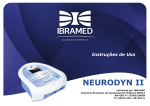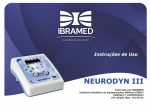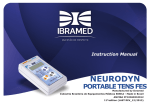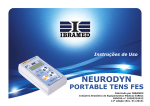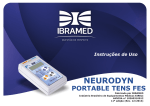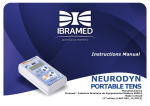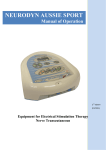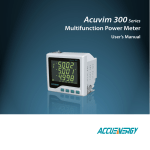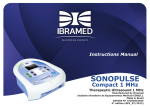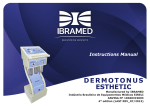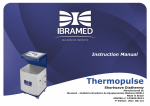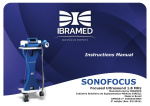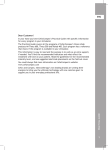Download Manual
Transcript
Instruction Manual NEURODYN Compact Manufactured by IBRAMED Indústria Brasileira de Equipamentos Médicos EIRELI ANVISA nº 10360310012 th 6 edition (REV. 08/2012) TABLE OF CONTENTS SYMBOL DEFINITIONS................................................3 CARTON............................................................4 ACCESSORIES USED.................................................34 ABREVIATIONS GLOSSARY...........................................5 OPERATING INSTRUCTIONS.......................................35 LIST OF FIGURES.......................................................5 PREPARE DEVICE.............................................35 FOREWORD...............................................................6 PROGRAMMING EQUIPMENT...............................36 ELECTROTHERAPY PATIENT PREPARATION...........37 ESSENTIAL PERFORMANCE..................................6 WAVEFORM SPECIFICATIONS.............................31 PRODUCT DESCRIPTION..............................................6 ELECTRODE GUIDELINE.............................................37 SAFETY PRECAUTIONS................................................7 USING THE MS/PROG BUTTON...................................40 INDICATIONS, CONTRAINDICATIONS, PRECAUTIONS AND SELECT THE LANGUAGE....................................40 ADVERSE REACTIONS...............................................10 USING THE PROG BUTTON.................................40 POPULATION AND CONDITIONS OF USE.......................14 PROGRAMMING USER PROTOCOLS.....................41 GENERAL CARE WITH THE EQUIPMENT........................15 CLINICAL RESOURCES LIBRARY - CLINICAL PROTOCOLS..42 SHIPPING DAMAGE...........................................15 REFERENCES...........................................................58 INSTALLATION, CARE AND CLEANING..................15 ACCESSORIES ACCOMPANYING NEURODYN COMPACT.......60 ENVIRONMENTAL PROTECTION...................................16 ELECTRICAL FEED.....................................................17 TROUBLESHOOTING.................................................62 ELECTROMAGNETIC COMPATIBILITY GUIDANCE............18 MAINTENANCE, WARRANTY AND TECHNICAL SUPPORT...62 ELETROMAGNECTIC COMPATIBILITY............................19 NOMENCLATURE.......................................................27 CONTROLS, INDICATORS AND CONNECTIONS......27 SYMBOL DEFINITIONS......................................29 SPECIFICATIONS......................................................30 SYSTEM SPECIFICATIONS..................................30 2 REPLACEMENT ACCESSORIES............................61 SYMBOL DEFINITIONS BELOW ARE THE DEFINITIONS OF THE SYMBOLS USED ON THE EQUIPMENT AND THROUGHOUT THE INSTRUCTIONS FOUND IN THIS MANUAL.UNDERSTAND THESE SYMBOLS AND THEIR DEFINITIONS BEFORE OPERATING THIS EQUIPMENT Caution! Refer to user manual. Sensitivity against electrostatic discharge. Start treatment. TYPE BF Electrical equipment. Stop treatment. Dangerous voltage. Off switch. CLASS II Electrical equipment. On swith. Not protected against the harmful effects of water penetration. Voltage in AC (Alternating Current). 3 SYMBOL DEFINITIONS CARTON Refer to operating instructions for correct product use. Fragile. This side up. Manufacturer’s name and address. Limits of temperature for storage and packaging in °C (Celsius Degrees). Keep away from the rain. Stacking up. Do not use if the packaging is damaged. 4 ABREVIATIONS GLOSSARY Hz kHz mA ms min s VA On Off Rise Decay LIST OF FIGURES Hertz Kilohertz Milliampere Milliseconds Minute Second Volt ampaere Time of Muscular Contraction Time of Muscular Relaxation Time of Increase Gradient Time of Decrease Gradient Figure 1. Upper Access Panel.....................................27 Figure 2. Rear Access Panel .....................................27 Figure 3. Front Access Panel....................................27 Figure 4. Lower Access Panel....................................26 Figure 5. A, Pin cables with banana ends (2 mm);......34 B, Self-adhesive conductive electrodes ;........35 C, neutral conductive gel.............................38 Figure 6. A e B, LCD Messages; C, NEURODYN COMPACT Electro Stimulator Default Screen...............................38 Figure 7. Bipolar Electrode Placement Technique.........39 Figure 8. Monopolar Electrode Placement Technique.....40 Figure 9. Electrode sizes and current density...............41 5 FOREWORD PRODUCT DESCRIPTION ESSENTIAL PERFORMANCE This user manual allows the user to efficiently use the NEURODYN Compact Electro Stimulator. It also gives suggestions for treatment protocols so that you can use your equipment to its full potential. Consult other resources for additional information regarding the uses of electrotherapy before attempting any treatment on a patient. Users must read, understand and follow the information in this manual for each mode of treatment available, as well as the indications, contraindications, warnings and precautions. The specifications and instructions in this manual are in effect at the time of its publication. These instructions may be updated at any time at the manufacturer’s discretion. Visit our website for updates. NEURODYN Compact transcutaneous neuromuscular stimulator is a two-channel stimulator with independent controls for current therapies used in: TENS (Transcutaneous Electrical Nerve Stimulation), FES (Functional Electrical Stimulation) and RUSSIAN CURRENT (Burst Modulated Medium Frequency). Treatment should be administered only under the direct supervision of a health care professional. 6 SAFETY PRECAUTIONS PRECAUTIONARY DEFINITIONS The precautionary instructions found in this section and throughout this manual are indicated by specific symbols. Understand these symbols and their definitions before operating this equipment prior to therapy session. • Read, understand, and practice the precautionary and operating instructions. Know the limitations and hazards associated with the use of any electrical stimulation. Observe the precautionary and operational labels placed on the unit. • DO NOT operate this unit in an environment where other devices intentionally radiate electromagnetic energy in an unshielded manner. • This unit should be operated, transported and stored at temperatures between 41°F and 122°F (5°C and 50°C); Avoid damp and dusty environments. Check cables and associated connectors before each use. • The NEURODYN Compact Electro Stimulator is not designed to prevent the infiltration of water or other liquids. The infiltration of water or other liquids could cause malfunction of internal components of the system and therefore create a risk of injury to the patient. • Disconnect the power plug from the outlet when left Text with a “CAUTION” indicator refers to potential safety infractions that could cause minor to moderate injury or damage to equipment. Text with a “WARNING” indicator refers to potential safety infractions that could cause serious injury and equipment damage. unused for long periods of time. Text with a “DANGER” indicator refers to potential safety infractions that represent immediately life threatening situations that would result in death or serious injury. 7 SAFETY PRECAUTIONS avoid the introduction of electrical current into the heart which may cause cardiac arrhythmia. • Stimulation should not be applied over swollen, infected, and inflamed areas or skin eruptions such as phlebitis, thrombophlebitis, varicose veins, etc. • Stimulation should not be applied on or near cancerous lesions. • Output current density depends on the electrode size. Improper application may result in patient injury. For any question related to the correct electrode size, consult a licensed practitioner prior to therapy session. • To protect against the risk of fire, only use replacement fuses of the same types and ratings. • Be sure the unit is grounded by connecting it to a grounded electrical outlet compliant with the applicable national and local electrical codes. • Powered muscle stimulators should be used only with the lead wires and electrodes recommended for use by the manufacturer. • Prior to patient treatment become familiar with the operating procedures for each mode of treatment available, as well as the indications, contraindications, warnings and precautions. Consult other resources for additional information regarding the applications of Electrotherapy. • To prevent electrical shock, disconnect the unit from the power source before performing any maintenance task. • Keep electrodes separated during treatment. Electrodes in contact with each other could result in improper stimulation or skin burns. • Stimulation should not be applied over the anterior neck or mouth. • Severe spasm of the laryngeal and pharyngeal muscles may occur and the contractions may be strong enough to close the airway or cause breathing difficulties. • Stimulation should not be applied transthoracically to 8 SAFETY PRECAUTIONS • Patients with an implanted neurostimulation device must not be treated with or be in close range of any shortwave diathermy, microwave diathermy, therapeutic ultrasound diathermy or laser diathermy anywhere on their body. Energy from diathermy (shortwave, microwave, ultrasound and laser) can be transferred through the implanted neurostimulation system, can cause tissue damage, and can result in severe injury or death. Injury, damage or death can occur during diathermy therapy even if the implanted neurostimulation system is powered “off.” • Equipment not suitable for use in the presence of a flammable anesthetic mixture with air, oxygen or nitrous oxide. 9 INDICATIONS, CONTRAINDICATIONS, PRECAUTIONS AND ADVERSE REACTIONS INDICATIONS FOR USE CONTRAINDICATIONS Indications for the currents: Russian and FES • Do not use this device on patients who have a cardiac pacemaker, implanted defibrillator, or other implanted metallic or electronic device because this may cause electric shock, burns, electrical interference, or death. • This device must not be used for the relief of local symptomatic pain without known etiology, unless a pain syndrome is diagnosed. • The stimulation must not be applied in patients with suspicion of transmittable infectious diseases and/or diseases in which it is advisable, for medical purposes, to suppress heat or fever. • Stimulation must not be applied on the nerves of the carotid sheath, particularly in patients with altered sensitivity to reflex of the carotid sinus. • Stimulation must not be applied over the neck or mouth. Spasms of the larynx and pharynx muscles may occur and the contractions may cause the closure of the upper airways or cause respiratory difficulties. • Stimulation must not be applied over the cardiac area because it might cause cardiac arrhythmia. • Stimulation must not be applied over the brain area. • Stimulation must not be applied over swollen, infected or inflamed areas, neither over skin eruptions such as phlebitis, thrombophlebitis, varicosis, etc • • • • • Prevention or treatment of atrophy for disuse. Increase in local blood circulation. Muscle reeducation. Maintenance or increase in amplitude of movement. Relaxation of spasmodic muscles. Indications for TENS current • • • • Symptomatic relief and treatment of chronic pain. Increase in local blood circulation. Symptomatic relief of acute post-traumatic pain. Acute postoperative pain. 10 INDICATIONS, CONTRAINDICATIONS, PRECAUTIONS AND ADVERSE REACTIONS PRECAUTIONS • Stimulation must not be applied over or next to cancerous lesions. • Stimulation must not be applied when the patient is in the shower or bathtub. • Stimulation must not be applied when the patient is sleeping. • Stimulation must not be applied when the patient is driving, operating machines, or during any activity in which electrical stimulation may put the patient in risk of lesion. • Stimulation with polarized current must not be applied over areas with metal implants. • Stimulation must be applied only on normal, intact, clean healthy skin. • Consult with a doctor before using this device, because the device may cause lethal disturbances in cardiac patients. • The long term effects of chronic electrical stimulations are not known. • The safety of neuromuscular stimulators for use during pregnancy has not been established. • Extreme care must be taken with patients with suspicion of cardiac problems or diagnosed cardiac problems. • Extreme care must be taken with stimulation treatment in the presence of the following: a) When there is a tendency of hemorrhage after acute trauma or fracture; b) Subsequently to recent surgical procedures, when the muscle contraction may disturb the wound healing process; c) During the menstruating uterus or pregnancy; d) Over areas of the skin which lack normal sensitivity. 11 INDICATIONS, CONTRAINDICATIONS, PRECAUTIONS AND ADVERSE REACTIONS ADVERSE REACTIONS • Some patients present skin irritation or hypersensitivity caused by electrical stimulation or electrical conducting medium. • The electrode placement and the stimulation configurations must be in accordance with the prescriptions and directions provided by a health professional. • Neuromuscular stimulators must be kept out of the reach of children. • Neuromuscular stimulators must be used only with those conductor wires and electrodes recommended by the manufacturer. • Patients may feel skin irritation and burning under the stimulation electrodes. • Patients may feel headache or other painful sensations during or after electrical stimulation next to the eyes, on the head or face. • Patients must stop to use the device and consult with a health professional if they feel adverse reactions after the use of the device. 12 RESPONSIBILITY FOR USE ELECTROMEDICAL EQUIPMENT The use of electromedical equipment is restricted to a physician or under his command, the physical therapists or health professionals properly licensed. The professional will be responsible for properly licensed use and operation of the equipment. IBRAMED makes no representations regarding laws and federal, state or local laws that may apply to the use and operation of any electromedical equipment. The physician or under his command, also the physical therapist or other professional health care licensed assumes total and full commitment to contact the local certifying agencies to determine any credential required by law for clinical use and operation of this equipment. The use of electromedical equipment must comply with the local, state and federal country. 13 POPULATION AND CONDITIONS OF USE PATIENT POPULATION • Patients over 12 years old, under this age only by medical prescription or physiotherapeutic indication; • Patients over 35 kg, under this weight only by medical prescription or physiotherapeutic indication; • There are no restrictions as of nationality; • Patients with preserved level of conscience and sensitivity. • There are no admissible deficiencies for the use of the equipment; • Regarding the frequency of use, this device is used according to clinical needs, up to several times a day and is reusable; • Regarding mobility, this device is considered a portable device. CONDITIONS OF USE • There are no requisites about a maximum level of education for the intended use. • Regarding the minimum level of knowledge of the user, it is necessary that the user knows the electro physical agents and their therapeutical effects. The user must know physiology, anatomy, and the basic sciences: chemistry, physics, and biology. The user is supposed to have studied or be presently studying physiology and anatomy; • A maximum level of knowledge is not required from the user; • The instructions of use are available in Portuguese, Spanish and English; • Regarding the minimum level of experience of the user, it is necessary that the instructions of use are read carefully and all the instructions are understood before the use of the device; 14 GENERAL CARE WITH THE EQUIPMENT SHIPPING DAMAGE INSTALLATION, CARE AND CLEANING Installation Instructions 1. Connect the line cord to the back of the NEURODYN Compact Electro Stimulator 2. Plug the line cord into a grounded wall outlet (100-240V ~ 50/60 Hz). 3. Plug the electrode cables into the electrode cable connections. 4. Switch on your equipment. Your NEURODYN Compact Electro Stimulator is shipped complete in one carton. Upon receipt, inspect carton and unit for visible and hidden damage. In case of damage, keep all shipping materials including carton and contact the shipping agent responsible for the delivery of the unit. All claims relating to damage during transport should be filed directly with them. The manufacturer will not be liable for any damage during shipping, nor allow for adjustments unless proper formal claim has been filed by the receiver against the carrier. The carton in which your NEURODYN Compact Electro Stimulator was received is specially designed to protect the unit during shipping. Please keep all shipping materials in case you need to return your unit for servicing. NEURODYN Compact Instructions Electro Stimulator Care • Avoid areas subject to vibrations. • Install the equipment on a firm and level surface, in open air. • Do not block ventilation. • Avoid humid, hot and dusty environments. • Make sure the area around the network cable is free. • Do not insert objects into device holes. Cleaning the NEURODYN Compact Electro Stimulator Disconnect the system from the power source, wipe with a clean, lint free cloth moistened with water and mild antibacterial soap. If a more sterile cleaning is needed, use a cloth moistened with an antimicrobial cleaner. Do not place the system in liquids. 15 ENVIRONMENTAL PROTECTION NEURODYN Compact is an electronic device and has heavy metal parts such as lead. So, there are risks of contamination to the environment associated with the discharge of this device and its accessories at the end of their service life. NEURODYN Compact, its parts and the accessories must not be disposed of as urban residues. Contact the local distributor to obtain information about norms and laws relative to the elimination of electrical residues, electronic equipment and their accessories. CORRECT EQUIPMENT INSTALLATION PREVENTS SECURITY RISKS The device and its consumable parts must be eliminated at the end of their shelf-life, according to the federal norms and/or state norms and/or local norms of each country. 16 ELECTRICAL FEED NEURODYN Compact is monophasic equipment, and it may be connected to mains voltage in the range of 100 to 240V ~ 50/60 Hz. Just connect the equipment to the power supply line and it will perform the of selection mains voltage automatically. The connecting cable to the power line is detachable. The equipment uses a mains plug as a resource to electrically separate its circuits in relation to the mains power in all the poles. Before turning on NEURODYN Compact, make sure: • The tension and frequency of the local mains voltage is equal to the one described on the label of power line and tension characteristics located in the rear part of the equipment. • To prevent electrical shock, do not use the plug in the equipment as an extension cable, or other types of plugs except the terminals fit completely in the receptacle. • Cleansing and disinfection must be performed with the power plug disconnected from the mains voltage. • Maintenance and technical assistance of NEURODYN Compact must always be performed at an authorized technical service only by qualified technicians. NOTES In the rear part of NEURODYN Compact there is a protection fuse. To replace it, turn the equipment off of the mains voltage line and with a screwdriver, remove the protection lid, disconnect the fuse and perform the replacement, then replace the protection lid. Always use the fuses indicated by Ibramed. Use the fuse for the nominal current of 5.0A, operation tension 250V~ and snap action model 20AG (rupture current of 50A). There are dangerous tensions inside the equipment. Never open the equipment. NEURODYN Compact does not need any type of current stabilizer. Never use power stabilizers. 17 ELECTROMAGNETIC COMPATIBILITY GUIDANCE NEURODYN Compact was developed to meet the requirements in IEC 60601-1-2 Electromagnetic Compatibility. The purpose of this standard is: • Ensure that the level of spurious signals generated by the equipment and irradiated to the environment are below the limits specified in IEC CISPR 11, Group 1, Class A (radiated emission). • Ensure the equipment immunity to electrostatic discharges, by contact and through the air, from the accumulation of static electric charges acquired by the body (Electrostatic Discharge - IEC 61000-4-2). • Ensure the immunity of equipment when subjected to an electromagnetic field incident from external sources (Radiated RF Immunity - IEC 61000-4-3). The use of accessories, other than those listed, except when supplied or sold by Ibramed Indústria Brasileita de Equipamentos Médicos EIRELI as replacement parts for internal or external components, may result in increased emission or decreased immunity of the NEURODYN Compact Electro Stimulator. Medical Electrical Devices require special attention regarding Electromagnetic Compatibility (EMC) and must be installed and put into service according to the EMC information provided in the following tables. 18 ELETROMAGNECTIC COMPATIBILITY POTENTIAL ELECTROMAGNETIC INTERFERENCE As for the limits for electromagnetic disturbances, NEURODYN Compact is electromagnetic equipment which belongs to Group 1 Class A. The simultaneous connection of the patient to NEURODYN Compact and surgical HF equipment may result in burns on the application area and possible damage to the equipment. Operation at short distance (1 meter, for example) from short wave therapy equipment may induce instability in the outlet of the equipment. To prevent electromagnetic interference, we suggest that one group of mains voltage is used for NEURODYN Compact and another, separate group is used for the other short wave or microwave equipment. We suggest that the patient, NEURODYN Compact and connection cables are installed at least 3 meters away from the short wave or microwave equipment. Portable and Mobile Radio Frequency communications equipment can affect Medical Electrical Devices. 19 (RF) ELETROMAGNECTIC COMPATIBILITY The electromedical devices demand special attention regarding electromagnetic compatibility (EMC) and must be installed and operated according to the EMC information provided as follows: Guidance and Manufacturer’s Declaration - Electromagnetic Emissions The NEURODYN Compact is intended for use in the electromagnetic environment specified below. The customer or the user of the NEURODYN Compact should ensure that it is used in such an environment. Emission Test Compliance RF Emissions NBR IEC CISPR 11 IEC CISPR 11 Group 1 RF Emissions NBR IEC CISPR 11 IEC CISPR 11 Class A Harmonic Emissions IEC 61000-3-2 Voltage fluctuations/ flicker emissions IEC 61000-3-3 Class A Electromagnetic environment - Guidance The NEURODYN Compact must emit electromagnetic energy in order to perform it’s intend function. Nearby electronic equipment may be affected. The NEURODYN Compact is suitable for use in all establishments other than domestic those directly connected to the public low-voltage power supply network that supplies buildings used for domestic purposes. Class A 20 ELETROMAGNECTIC COMPATIBILITY Guidance and Manufacturer’s Declaration - Electromagnetic Immunity The NEURODYN COMPACT is intended for use in the electromagnetic environment specified below. The customer or the user of the NEURODYN COMPACT should assure that it is used in such an environment. Immunity Test Electrostatic discharge (ESD) IEC 61000-4-2 Electrical fast Transitories/burst IEC 61000-4-4 Surge IEC 61000-4-5 IEC 60601 Test Level Compliance Level Electromagnetic Environment - Guidance 6 kV by contact 8 kV by air 6 kV by contact 8 kV by air Floors should be wood, concrete or ceramic tile. If floors are covered with synthetic material, the relative humidity should be at least 30%. 2 kV for power supply lines 1 kV for input/ output lines 2 kV for power supply lines 1 kV for input/ output lines 1 kV diferencial mode 2 kV common mode 1 kV diferencial mode 2 kV common mode 21 Mains power quality should be that of a typical commercial or hospital environment. Mains power quality should be that of a typical commercial or hospital environment. ELETROMAGNECTIC COMPATIBILITY Immunity Test Voltage dips, short interruptions and voltage variations in power input lines IEC 61000-4-11 Power frequency (50/60 Hz) magnetic fild IEC 60601 Test Level Compliance Level < 5% UT (> 95% voltage drops in UT ) 0,5 by cyclo < 5% UT (> 95% voltage drops in UT ) by 0,5 cycle 40% UT (60% voltage drops in UT ) by 5 cycles 40% UT (60% voltage drops in UT ) by 5 cycles 70% UT (30% voltage drops in UT ) by 25 cycles 70% UT (30% voltage drops in UT ) by 25 cycles < 5% UT (> 95% voltage drops in UT ) by 5 seconds < 5% UT (> 95% voltage drops in UT ) by 5 seconds 3 A/m Electromagnetic Environment - Guidance Mains power quality should be that of a typical commercial or hospital environment. If the user of the NEURODYN Compact requires continued operation during power mains interruptions, it is needed that the NEURODYN Compact be powered from an uninterruptible power supply or battery. Power frequency magnetic fields should be at levels characteristic of a typical location in a typical commercial or hospital environment. 3 A/m IEC 61000-4-8 NOTA: UT is the A.C. mains voltage prior to applications of the test level. 22 ELETROMAGNECTIC COMPATIBILITY Guidance and Manufacturer’s Declaration - Electromagnetic Immunity The NEURODYN Compact is intended for use in the electromagnetic environment specified below. The customer or the user of the NEURODYN Compact should assure that it is used in such an environment. Compliance IEC 60601 Electromagnetic Environment - Guidance Immunity Test Level Test Level Portable and mobile RF communication equipment should not be used no closer to any part of NEURODYN Compact, including cable than be separation distance calculated from the equation applicable to the frequency of the transmitter. Recommended separation distance Conducted RF IEC 61000-4-6 Radiated RF IEC 61000-4-3 3 Vrms 150 kHz to 80 MHz 3 V/m 80 MHz to 2.5 GHz P d = 0.35 P 80 MHz to 800 MHz d = 0.7 P 800 MHz to 2.5 GHz d = 1.2 3V Where p is the maximum output power rating of the transmitter in watts (W) according to the transmitter manufacturer and d is the recommended separation distance in meters (m). Field strengths from fixed RF transmitters, as determined by an electromagnetic site survey,a should be less than the compliance level in each frequency range. b Interference may occur in the vicinity of equipment marked with the following symbol: 3 V/m 23 ELETROMAGNECTIC COMPATIBILITY NOTE 1: At 80 MHz and 800 MHz the higher frequency range applies. NOTE 2: These guidelines may not apply in all situations. Electromagnetic propagation is affected by absorption and reflection from structures, objects and people. a Field strengths set by fixed transmitters, such as radio base stations, telephone (cellular/cordless) telephones and land mobile radios, amateur radio, AM / FM radio broadcast and TV broadcast cannot be predicted theoretically with accuracy. To assess the electromagnetic environment due to fixed RF transmitters, an electromagnetic site survey should be considered. If the measured field strength at the location in which the NEURODYN COMPACT is used exceeds the applicable RF compliance level above, the NEURODYN COMPACT should be observed to verify normal operation. If abnormal performance is observed, additional measures may be necessary, such as reorientation or relocating the NEURODYN COMPACT. b Over the frequency range 150 kHz to 80 MHz, field strengths should be less than 3V / m. b 24 ELETROMAGNECTIC COMPATIBILITY Recommended separation distances between the mobile RF communication equipment and NEURODYN The NEURODYN Compact is intended for use in an electromagnetic environment in which radiated RF disturbances are controlled. The customer or the user of the NEURODYN Compact can help prevent electromagnetic interference by maintaining a minimum distance between portable and mobile RF communications equipment (transmitters) and the NEURODYN Compact as recommended below, according to the maximum output power of the communications equipment. Rated maximum power output of transmitter w Separation distance according to frequency of transmitter m 150 kHz to 80 MHz d = 1.2 P 80 MHz to 800 MHz d = 0.35 P 800 MHz to 2.5 GHz d = 0.7 P 0,01 0.12 0.12 0.23 0,1 0.38 0.38 0.73 1 1.2 1.2 2.3 10 3.8 3.8 7.3 100 12 12 23 For transmitters rated at a maximum output power not listed above, the recommended separation distance d in meters (m) can be estimated using the equation applicable to the frequency of the transmitter, where P is the maximum output power rating of the transmitter in watts (W) according to the transmitter manufacturer. NOTE 1: 80 MHz to 800 MHz, the separation distance for the higher frequency range applies. NOTE 2 These guidelines may not apply in all situations. Electromagnetic propagation is affected by absorption and reflection from structures, objects and people. 25 ELETROMAGNECTIC COMPATIBILITY Equipment: Serial number: ANVISA Reg istration ( M.S.): Man ufacturing d ate: Expiratio n date: 5 years Senior engineeer: Maicon String hetta CREA - 5062850975 26 NOMENCLATURE CONTROLS, INDICATORS AND CONNECTIONS 5 4 7 3 8 9 6 Figure 2. Rear Access Panel. 2 Figure 1. Upper Access Panel. 10 Figure 3. Front Access Panel. 27 NOMENCLATURE 1- Power ON/OFF Switch 2- Power On Indicator LED 3- SELECT control Key 4- SET control key 14 5- Alphanumerical LCD display 15 6- START/STOP control key 7- PROG/MENU control key PROG: selection of preprogrammed protocols; MENU: language selection 8- Light indicators (yellow) of channels 1 and 4 9- UP and DOWN control keys – individual channel intensity 10- Outlet connections cables to patient 11- Protection fuse 12- Connection to power cable Figure 4. Lower Access Panel. 13- General technical information 14- Label with technical characteristics 15- Serial number 28 NOMENCLATURE SYMBOL DEFINITIONS Read and Understand these symbols and their definitions before operating this equipment Before using and operating the NEURODYN Compact Electro Stimulator, please read and learn the symbols on the LCD device Button used to start or stop the treatment. Always press the center key. Channel Lead Wire Connectors. Channel 1 and 2. Double Function Key: PROG – Selection of pre-programmed protocols and private protocols; MENU – Selection of language (Portuguese, English or Spanish). SELECT key: selection of the parameters of ultrasound. UP or Down: Channel 1 and 2. Observe the colors related to channels. SET key: selection of the values of the parameters. 29 SPECIFICATIONS SYSTEM SPECIFICATIONS Dimensions Temperature Range During Transport and Storage: 5 - 50 °C / 41 - 122°F. Width 27 cm (10.6 in) Depth: 26.6 cm (10.4 in) Height 12.5 cm (4.9 in) Standard Weight (without accessories): 1.85 kg Environment operating temperature range: 5 - 45 °C / 41- 113 °F. Power Input: Input Power: Fuses: Electrical Class: Electrotherapy: 100 - 240V~ 50/60 Hz 85 VA 5A 250V~ (20AG) Fast Action Rupture capacity 35A CLASS II TIPE BF Regulatory Compliance IEC IEC IEC IEC 60601-1 60601-1-2 60601-1-4 60601-2-10 30 SPECIFICATIONS WAVEFORM SPECIFICATIONS TENS Transcutaneous Electrical Nerve Stimulation Frequency/Phase Duration Variation: VIF Frequency VIF Phase Duration The Symmetrical Biphasic waveform has a short pulse duration and is capable of strong stimulation of nerve fibers in the skin and in muscle. TENS is a classic current used for treatment of pain by sensorial stimulation and the patient typically tolerates the current well, even at relatively high intensities. VIF 2-247 Hz 50-500 μs Current Mode Normal (Continuous) Burst Modulation Tens Conv (R 0.5-250 Hz; T 50-500 μs) Tens Burst (R 250 Hz; T 50-500 μs) Treatment Time Set Intensity 1-60 min Individual channel intensities 1 and 2 *Impedance bandwidth of charge for the mentioned parameters (1000 Ohms). Output Mode Output Intensity Frequency (R) Phase Duration (T): Burst Frequency Modulation of Burst Frequency Electrodes 0-250 mA* 0.5-250 Hz Adjustable 50-500 μs 2 Hz 250 Hz 31 SPECIFICATIONS FES Function Electrical Stimulation Functional Electrical Stimulation (FES) uses low levels of electrical current to stimulate physical or bodily functions lost through nervous system impairment. Ramp Rise (Time of Increase Gradient) On (Time of Muscular Contraction) Decay (Time of Decrease Gradient) Off (Time of Muscular Relaxation) 1-9 s 1-60 s 1-9 s 1-60 s Treatment Time 1-60 min Set Intensity Individual channel intensity setting 1 and 2 *Impedance bandwidth of parameters (1000 Ohms). Output Mode Electrodes Output Intensity 0-250 mA* Frequency (R) 0.5-250 Hz Current Mode: Synchronous Fes Sync (1&2 channel) Reciprocal Fes Rec (1 or 2 channel) Phase Duration (T) 50-500 μs Frequency/Phase Duration Variation: VIF VIF Frequency 2-247 Hz VIF Phase duration 50-500 μs 32 charge for the mentioned SPECIFICATIONS RUS Russian Current Ramp Rise (Time of Increase Gradient) On (Time of Muscular Contraction) Decay (Time of Decrease Gradient) Off (Time of Muscular Relaxation) The Russian current is an alternated current of medium frequency (2.5 kHz) modulated in rectangular bursts with frequency of 50 Hz and work cycle of 50%, used to produce muscle strengthening without significant discomfort for the patient. Treatment Time Set Intensity 1-9 s 1-60 s 1-9 s 1-60 s 1-60 min Individual channel intensity 1 and 2 *Impedance bandwidth of charge for the mentioned parameters (1000 Ohms). Output Mode Output Intensity Current Mode: Continuous Synchronous Reciprocal Burst Duration (Duty Cycle) Burst Frequency Electrodes 0-250 mA* Russian Cont (1 & 2 channel) Russian Sync (1 & 2 channel) Russian Rec (1 &2 channel) 10%, 20%, 30%, 40% e 50% 10-100 Hz (steps of 10 Hz) 33 ACCESSORIES USED TENS, FES and RUSSIAN CURRENT: pin connector cables with banana ends (2 mm) and conductive self-adhesive electrodes and neutral conductive gel (Figure 5). A B C Figura 5. A, Pin cables with banana ends (2 mm); B, Self-adhesive conductive electrodes; e C, neutral conductive gel • The connector screws must be firmly affixed to your connection on the back panel of the device. • To remove the banana pins self-adhesive electrodes, pull them by their protective cover. Never pull the cord. 34 OPERATING INSTRUCTIONS PREPARE DEVICE Edit Waveform Param The SELECT button allow you to select the parameters required for the treatment. Press the cursor keys to move to the next parameter or rewind the cursor back to the previous setting. The SET buttons allow you to select the values of each parameter required for the treatment. Turn the power switch. LCD displays the message device presentation for a few seconds, followed by the software model of the device default screen programming (Figure 6). A Time Parameters Set the session time. At the end of the scheduled time, you will hear a beep indicating that the emission current has been interrupted. Press the STOP button, the sound signal turns off and the equipment goes back to the programming status. B Patient preparation Prepare the patient for therapy as described and read about the use of electrodes. Start Treatment Press the START button to begin therapy session. Stop Treatment Press the STOP button to end therapy session. Figure 6. A, LCD Messages; B,NEURODYN Compact Electro Stimulator Default Screen. Note that entering the default screen will cause the word TENS to flash. This is to do with the ‘selection cursor parameters’ function which displays whenever the device is being programmed. 35 OPERATING INSTRUCTIONS Waveform Intensit 2. With the SELECT and SET - keys, scroll through the other parameters and select the values shown in the example. The Waveform Intensity may be increased or decreased at any time during the session. Press the INTENSITY button UP or DOWN. PROGRAMMING EQUIPMENT Example 1: Suppose the clinical practice or literature to suggest certain pathology TENS current type with automatic variation of intensity and frequency (VIF ON) and the treatment time of 40 minutes. 1. Connect the equipment to start programming the pattern described above. Note the blinking cursor in the CURRENT TYPE field. 36 OPERATING INSTRUCTIONS ELECTRODE GUIDELINE ELECTROTHERAPY PATIENT PREPARATION 3. Press the UP or DOWN channel in use to select the amount of current needed to treat. • Electrode Placement can be achieved using the Bipolar or Monopolar Techniques. Proper positioning and contact will insure treatment comfort and efficiency. • Examine the skin for any wounds and clean the treament area by rubbing the skin with medical grade alcohol. • Remove the self-adhesive electrodes from the protective backing and apply to the treatment area as prescribed. • Ensure the entire electrode surface is in contact with patient skin by pressing into place. • Check the electrode contact regularly during treatment. • Examine the skin again after the treatment. • Electrode – Biocompatibility (ISO 10993): Ibramed declares that the electrodes supplied with the equipment do not cause allergic reactions. These electrodes must only be put in contact with the integral surface of the skin, respecting the time limit of the duration of this contact of up to 24 hours. 4. Now press the START button to start treatment. Note: The intensity adjustment can be done before or after pressing the START key. To adjust the intensity before pressing the START, the operator must adjust the amount of current required for a given patient and after the START key is pressed an increase in intensity will gradually occur until it reaches the amount of current preset by the operator. If, during the gradual increase in intensity, the operator realizes that the previously set amount of current is above the limit tolerable by the patient, press the DOWN key to decrease the amount of current until it reaches the amount of current to the ideal to the patient. 5. At the end of the programmed time, the emission current is interrupted and an audible alarm will signal the treatment end. 6. Press the STOP button to stop the alarm. The equipment can now be switched off, repeat the same programming task, or undertake a new programming task. 37 ELECTRODE GUIDELINE Bipolar Electrode Placement Technique Monopolar Electrode Placement Technique Bipolar Electrode Placement Techniques should be used to provide stimulation to larger muscle groups, such as the quadriceps or the hamstrings. Equal size electrodes are placed at each end of the muscle or muscle group.The symmetrical waveforms of the Biphasic, Medium Frequency and Bipolar Interferential (Premodulated) are usually applied to the body using the Bipolar Technique. The NEURODYN COMPACT Electro Stimulator offers waveforms of the Nervous Transcutaneous Electrical Stimulation (TENS), Functional Electrical Stimulation (FES) and Russian Current (RUS). The Monopolar Electrode Placement Technique has been found to be especially useful for muscle stimulation of the upper extremities and small muscle groups. The smaller electrode is placed over the muscle motor point and the larger electrode is placed over the painful area. Monopolar Techniques may be used with the Waveforms Symmetrical Biphasic, Medium Frequency and Bipolar Interferential (Premodulated). The NEURODYN COMPACT Electro Stimulator offers Waveforms of the Nervous Transcutaneous Electrical Stimulation (TENS), Functional Electrical Stimulation (FES) and Russian Current (RUS). Figure 7. Bipolar Electrode Placement Technique. Figure 8. Monopolar Electrode Placement Technique. 38 ELECTRODE GUIDELINE Placement of the electrodes near the chest may increase the risk of cardiac fibrillation. Electrode Sizes and Current Density The size of the electrodes and the energy density used during therapy must comply with IEC 60601-2-10, i.e., the current density per area of electrode should not exceed 2 mA/cm2. Follow the manufacturer’s instructions. Figure 9. Electrode sizes and current density. 39 USING THE MS/PROG BUTTON SELECT THE LANGUAGE USING THE PROG BUTTON The MS/PROG button is used to select the language. Press MS/PROG until you hear three “beeps.” Select the desired language: ‘Português’, ‘Español or ‘English’ Short press MS/ PROG to set the chosen language. Connect the equipment as described above. Briefly press PROG and the following information will appear on the LCD. This is the first equipment to offer a choice of Treatment Protocols. Use the SET + / SET - buttons to select another protocol. If this is the protocol chosen, press the PROG key once again. The LCD displays the parameters of the equipment scheduled for the selected protocol. Then simply press the START button and select the desired current density. Proceed the same way to select any of the protocols available. Simply follow the steps above. Figure 10. Message language selection. 40 USING THE MS/PROG BUTTON PROGRAMMING USER PROTOCOLS PROGRAMMING THE MANUAL STIMULATION To program new protocols, briefly press the key PROG and press the SET button to select user protocols. With the SET button choose one of the 20 available user protocols. Enter the parameters according to therapeutic needs and press START. The last set parameters will be recorded in the device memory. To access Protocols saved by the user, simply select the PROG key and the SET key to choose the protocol number desired. 1) To program manual stimulation it is necessary to adjust the parameters to be used in therapy with Sync Fes ( Fes Synchronous) or Rec Fes (Fes Reciprocal) modes, except the parameter OFF, because it is the therapist who will manually trigger stimulation. 2) When selecting the function EST MANUAL (Manual Stimulation), the stimulation will be performed manually. For this function to be active (ON), the therapist must select the EST MANUAL mode using the SELECT and SET keys to select ON. 3) Then press the START button to begin therapy. In this function, the device performs the rise, on, and decay ramp ,that is its remains off (rest) for the period that the therapist deems necessary. 4) To start stimulation again press the PROG key, which, when pressed, will perform the stimulation. It is necessary to press the PROG key aech time for a new stimulation. Figure 11. Display to select the programmed and user protocols. 5) The manual stimulation mode is active until the end of the programmed time of treatment. To cancel the therapist must trigger the STOP button. 41 CLINICAL RESOURCES LIBRARY - CLINICAL PROTOCOLS Prog: 1 - TENS Prog: 2 -TENS Trigger points pain control Description: Modulation trigger points pain Parameters values Acute pain treatment of Parameters values Description: Modulation of acute pain Mode Tens Conv Mode Tens Conv Frequency (R) 10 Hz Frequency (R) 170 Hz Phase duration (T) 500 μs Phase duration (T) 50 μs Treatment time 2 min Treatment time 30 min Intensity 1-250 mA* Intensity 1-250 mA* Positioning of electrodes On the painful area Positioning of electrodes One electrode on the muscular trigger point and the other 7 cm away from the main electrode *The manufacturer does not indicate the necessary intensity in the protocol because it should be adjusted by the therapist according to the clinical needs of each patient. The intensity should be adjusted using the Up and Down keys. 42 CLINICAL RESOURCES LIBRARY - CLINICAL PROTOCOLS Prog: 3 - TENS Prog: 4 - FES Chronic pain treatment Motor recovery after surgery Parameters values Parameters values Description: Post Surgery Stimulation for functional motion recovery Description: Modulation of chronic pain Mode Tens Conv Frequency (R) 40 Hz Mode Frequency (R) Phase duration (T) 150 μs Phase duration (T) 250 μs Treatment time 20 min Rise 3s Intensity 1-250 mA* On 8s Decay 1s Off 8s Positioning of electrodes The conductive rubber electrodes that are positioned in at the local to be treated, positioned around the area to be stimulated, this area should be between the electrodes. Treatment time Intensity Positioning of electrodes Fes Sync 50 Hz 25 min or the desired number of muscle contractions 1-250 mA* In the muscular centre or on the motor muscular point *The manufacturer does not indicate the necessary intensity in the protocol because it should be adjusted by the therapist according to the clinical needs of each patient. The intensity should be adjusted using the Up and Down keys. 43 CLINICAL RESOURCES LIBRARY - CLINICAL PROTOCOLS Prog: 6 - FES Prog: 5 - FES Increase muscle strength in athletes 1 Increase muscle strength in athletes 2 Parameters values Description: Stimulation for conditioned muscle (intermediate phase) Description: Stimulation for conditioned muscle (initial phase) Mode Frequency (R) Phase duration (T) Mode Frequency (R) Fes Sync 60 Hz Phase duration (T) 350 μs Rise 3s Rise On 12 s On Decay Off Treatment time Intensity Positioning of electrodes Parameters values Decay 1s 20 s Off 25 min or the desired number of muscle contractions Treatment time 1-250 mA* Intensity In the muscular centre or on the motor muscular point Positioning of electrodes Fes Sync 60 Hz 350 μs 3s 15 s 1s 15 s 25 min or the desired number of muscle contractions 1-250 mA* In the muscular centre or on the motor muscular point *The manufacturer does not indicate the necessary intensity in the protocol because it should be adjusted by the therapist according to the clinical needs of each patient. The intensity should be adjusted using the Up and Down keys. 44 CLINICAL RESOURCES LIBRARY - CLINICAL PROTOCOLS Prog: 8 - FES Prog: 7 - FES Increase muscle strength in athletes 3 Increase of muscle strength after ACL injury 1 Parameters values Description: Increase of muscle strength in patients with LCA lesion with or without ligamentoplasty (initial phase) Mode Frequency (R) Description: Stimulation for conditioned muscle (advanced phase) Mode Frequency (R) Phase duration (T) Fes Sync 60 Hz Phase duration (T) 350 μs Parameters values Fes Sync 50 Hz 250 μs Rise 3s Rise 3s On 18 s On 6s Decay 1s Decay Off Treatment time Intensity 1s 18 s 25 min or the desired number of muscle contractions 1-250 mA* Off 12 s Treatment time 25 min Intensity 1-250 mA* In the muscular centre or on the motor muscular point of Positioning of electrodes Positioning of electrodes the rectus femoris muscles, vastus lateralis and vastus medialis *The manufacturer does not indicate the necessary intensity in the protocol because it should be adjusted by the therapist according to the clinical needs of each patient. The intensity should be adjusted using the Up and Down keys. No ventre muscular ou sobre o ponto motor 45 CLINICAL RESOURCES LIBRARY - CLINICAL PROTOCOLS Prog: 10 - FES Prog: 9 - FES Increase of muscle strength values after ACL injury 2 Description: Increase of muscle strength in patients with LCA lesion with or without ligamentoplasty (intermediate phase) Mode Frequency (R) Phase duration (T) Increase of muscle strength after ACL injury 3 Description: Increase of muscle strength in patients with LCA lesion with or without ligamentoplasty (advanced phase) Parameters values Fes Sync Mode Frequency (R) 50 Hz 250 μs Phase duration (T) Parameters values Fes Sync 60 Hz 300 μs Rise 3s Rise 3s On 10 s On 15 s Decay 1s Decay 1s Off 15 s Off 15 s Treatment time 25 min Treatment time 25 min Intensity 1-250 mA* Intensity 1-250 mA* Positioning of electrodes In the muscular centre or on the motor muscular point of the rectus femoris muscles, vastus lateralis and vastus medialis Positioning of electrodes In the muscular centre or on the motor muscular point of the rectus femoris muscles, vastus lateralis and vastus medialis *The manufacturer does not indicate the necessary intensity in the protocol because it should be adjusted by the therapist according to the clinical needs of each patient. The intensity should be adjusted using the Up and Down keys. 46 CLINICAL RESOURCES LIBRARY - CLINICAL PROTOCOLS Prog: 11 - FES Increase of muscular strength - knee surgery prosthesis 1 Description: Increase of muscle strength in patients subject to surgery for knee prosthetics implant (initial phase) Mode Frequency (R) Phase duration (T) Prog: 12 - FES Increase of muscular strength - knee surgery prosthesis 2 Description: Increase of muscle strength in patients subject to surgery for knee prosthetics (intermediate phase) Parameters values Fes Sync Mode Frequency (R) 40 Hz 250 μs Phase duration (T) Parameters values Fes Sync 40 Hz 250 μs Rise On 5s Rise 5s 6s On 10 s Decay 2s Decay 2s Off 15 s Off 15 s Treatment time 35 min Treatment time 35 min Intensity 1-250 mA* Intensity 1-250 mA* In the muscular centre or on In the muscular centre or on the motor muscular point of the motor muscular point of Positioning of electrodes the rectus femoris muscles, the rectus femoris muscles, Positioning of electrodes vastus lateralis and vastus vastus lateralis and vastus medialis medialis *The manufacturer does not indicate the necessary intensity in the protocol because it should be adjusted by the therapist according to the clinical needs of each patient. The intensity should be adjusted using the Up and Down keys. 47 CLINICAL RESOURCES LIBRARY - CLINICAL PROTOCOLS Prog: 14 - FES Prog: 13 - FES Increase of muscular strength knee surgery prosthesis 3 Description: Increase of muscle strength in patients subject to surgery for implanting of knee prosthetics (advanced phase) Mode Frequency (R) Phase duration (T) Increase of muscular strength after PNL 1 Parameters values Description: Increase of muscle strength in patients with peripheral nerve lesions (initial phase) Mode Frequency (R) Fes Sync 40 Hz 250 μs Phase duration (T) Parameters values Fes Sync 65 Hz 300 μs Rise 5s Rise 5s On 15 s On 3s Decay 2s Decay 2s Off 15 s Off 20 s Treatment time 35 min Treatment time 30 min Intensity 1-250 mA* Intensity 1-250 mA* In the muscular centre or on In the muscular centre of the the motor muscular point of Posição dos eletrodos denervated muscles the rectus femoris muscles, Posição dos eletrodos vastus lateralis and vastus medialis *The manufacturer does not indicate the necessary intensity in the protocol because it should be adjusted by the therapist according to the clinical needs of each patient. The intensity should be adjusted using the Up and Down keys. 48 CLINICAL RESOURCES LIBRARY - CLINICAL PROTOCOLS Prog: 16 - FES Prog: 15 - FES Increase of muscular strength after PNL 2 Increase of muscular strength after PNL 3 Parameters values Description: Increase of muscle strength in patients with peripheral nerve lesions (advanced phase) Description: Increase of muscle strength in patients with peripheral nerve lesions (intermediate phase) Mode Frequency (R) Phase duration (T) Parameters values Fes Sync Mode Frequency (R) 65 Hz Phase duration (T) 300 μs Fes Sync 65 Hz 300 μs Rise 5s Rise 5s On 6s On 10 s Decay 2s Decay 2s Off 18 s Off 18 s Treatment time 30 min Treatment time 30 min Intensity 1-250 mA* Intensity 1-250 mA* Positioning of electrodes In the muscular centre of the denervated muscles Positioning of electrodes In the muscular centre of the denervated muscles *The manufacturer does not indicate the necessary intensity in the protocol because it should be adjusted by the therapist according to the clinical needs of each patient. The intensity should be adjusted using the Up and Down keys. 49 CLINICAL RESOURCES LIBRARY - CLINICAL PROTOCOLS Prog: 18 - FES Prog: 17 - FES Increase of muscular strength after stroke 1 Increase of muscular strength after stroke 2 Parameters values Descrição: Aumento da força e facilitação muscular em pacientes com AVC para uso no ombro subluxado (fase intermediária) Descrição: Aumento da força e facilitação muscular em pacientes com AVC para uso no ombro subluxado (fase inicial) Mode Frequency (R) Phase duration (T) Parameters values Fes Sync Mode Frequency (R) 40 Hz 300 μs Phase duration (T) Fes Sync 40 Hz 300 μs Rise 5s Rise 5s On 8s On 10 s Decay 2s Decay 2s Off 18 s Off 18 s Treatment time 30 min Treatment time 30 min Intensity 1-250 mA* Intensity 1-250 mA* Positioning of electrodes On the centers of the supraspinal muscle and medial deltoid fibers to be moved during functional activity Positioning of electrodes On the centers of the supraspinal muscle and medial deltoid fibers to be moved during functional activity *The manufacturer does not indicate the necessary intensity in the protocol because it should be adjusted by the therapist according to the clinical needs of each patient. The intensity should be adjusted using the Up and Down keys. 50 CLINICAL RESOURCES LIBRARY - CLINICAL PROTOCOLS Prog: 20 - FES Prog: 19 - FES Increase of muscular strength after stroke 3 Description: Increase of strength and muscular facilitation in patients with stroke for use in subluxated shoulder (advanced phase) Mode Frequency (R) Phase duration (T) Spasticity control 1 Parameters values Description: Reduction of muscle spasticity in patients with central nervous system/ higher motoneuronal lesions (initial phase) Mode Frequency (R) Fes Sync 40 Hz Phase duration (T) 300 μs Parameters values Fes Sync 50 Hz 300 μs Rise 5s Rise 5s On 12 s On 12 s Decay 2s Decay 2s Off 18 s Off Treatment time 30 min Treatment time Intensity 1-250 mA* Intensity On the centers of the supraspinal muscle and medial deltoid fibers to be moved during functional activity 17 s 15 min or the desired number of muscle contractions 1-250 mA* On the muscle centre or on the Positioning of electrodes motor muscular point of the opposite muscle in relation to the spastic muscle *The manufacturer does not indicate the necessary intensity in the protocol because it should be adjusted by the therapist according to the clinical needs of each patient. The intensity should be adjusted using the Up and Down keys. Positioning of electrodes 51 PROTOCOLOS PRE-PROGRAMADOS Prog: 21 - FES Spasticity control 2 Prog: 22 - FES Parameters values Spasticity control 3 Description: Reduction of muscle spasticity in patients with central nervous system/ higher motoneuronal lesions (intermediate phase) Mode Frequency (R) Phase duration (T) Parameters values Description: Reduction of muscle spasticity in patients with central nervous system/ higher motoneuronal lesions (advanced phase) Fes Sync Mode Frequency (R) 50 Hz 300 μs Phase duration (T) Fes Sync 50 Hz 300 μs Rise 5s Rise 5s On 15 s On 17 s Decay 2s Decay 2s Off Treatment time Intensity 17 s Off 15 min or the desired number of muscle contractions Treatment time 1-250 mA* Intensity 17 s 15 min or the desired number of muscle contractions 1-250 mA* On the muscle centre or on the On the muscle centre or on the motor muscular point of the Positioning of electrodes motor muscular point of the Positioning of electrodes opposite muscle in relation to opposite muscle in relation to the spastic muscle the spastic muscle *The manufacturer does not indicate the necessary intensity in the protocol because it should be adjusted by the therapist according to the clinical needs of each patient. The intensity should be adjusted using the Up and Down keys. 52 CLINICAL RESOURCES LIBRARY - CLINICAL PROTOCOLS Prog: 23 - FES Increase of local muscular resistance 1 Prog: 24 - FES Increase of local muscular resistance 2 Parameters values Description: Increase of the localized muscle resistance (initial phase) Mode Frequency (R) Phase duration (T) Parameters values Description: Increase of the localized muscle resistance (intermediate phase) Fes Sync Mode Frequency (R) 20 Hz Phase duration (T) 300 μs Fes Sync 20 Hz 300 μs Rise 5s Rise 5s On 25 s On 35 s Decay Off Treatment time Intensity Positioning of electrodes Decay 2s 45 s Off Treatment time 40 min (3 times per day) 1-250 mA* Intensity On the muscular center or on the motor muscular point Positioning of electrodes 2s 50 s 40 min (3 times per day) 1-250 mA* On the muscular center or on the motor muscular point *The manufacturer does not indicate the necessary intensity in the protocol because it should be adjusted by the therapist according to the clinical needs of each patient. The intensity should be adjusted using the Up and Down keys. 53 CLINICAL RESOURCES LIBRARY - CLINICAL PROTOCOLS Prog: 26 - RUSSIAN Prog: 25 - FES Increase of local muscular resistance 3 Russian current Parameters values Description: Muscular stimulation through Russian Current Description: Increase of the localized muscle resistance (advanced phase) Mode Frequency (R) Phase duration (T) Parameters values Fes Sync Mode 20 Hz 300 μs Fes Sync Burst duration 50 % Burst Frequency 50 Hz Rise 5s Rise 3s On 40 s On 8s Decay 3s Decay Off Treatment time Intensity Positioning of electrodes 2s 55 s 40 min (3 times per day) 1-250 mA* On the muscular center or on the motor muscular point Off 16 s Treatment time 25 min Intensity 1-250 mA* Positioning of electrodes On the muscular center or on the motor muscular point *The manufacturer does not indicate the necessary intensity in the protocol because it should be adjusted by the therapist according to the clinical needs of each patient. The intensity should be adjusted using the Up and Down keys. 54 PROTOCOLOS PRE-PROGRAMADOS Prog: 27 - RUSSIAN Original Russian current for flaccidity 1– IIa fibers Prog: 28 - RUSSIAN Original Russian current for flaccidity 2 - IIa Fibers Parameters values Parameters values Description: Increase of muscular strength, emphasis on type IIa fibers (intermediate phase). Description: Increase of muscular strength, emphasis on type IIa fibers (initial phase). Mode Fes Sync Mode Russian Sync Burst Frequency 50 Hz Burst Frequency 50 Hz Rise 3s Rise 3s On 6s On 9s Decay 3s Decay 3s Off 12 s Off 15 s Treatment time 15 min Treatment time 15 min Intensity 1-250 mA* Intensity 1-250 mA* Positioning of electrodes Bipolar Positioning of electrodes Bipolar *The manufacturer does not indicate the necessary intensity in the protocol because it should be adjusted by the therapist according to the clinical needs of each patient. The intensity should be adjusted using the Up and Down keys. 55 PROTOCOLOS PRE-PROGRAMADOS Prog: 29 - RUSSIAN Original Russian current for flaccidity 3 - IIa Fibers Prog: 30 - RUSSIAN Original Russian current for flaccidity 1 - IIb Fibers Parameters values Description: Increase of muscular strength, emphasis on type IIa fibers (advanced phase). Parameters values Description: Increase of muscular strength, emphasis on type IIb fibers (initial phase). Mode Russian Sync Mode Russian Sync Burst Frequency 50 Hz Burst Frequency 70 Hz Rise 3s Rise 3s On 12 s On 6s Decay 3s Decay 3s Off 18 s Off 12 s Treatment time 15 min Treatment time 15 min Intensity 1-250 mA* Intensity 1-250 mA* Positioning of electrodes Bipolar Positioning of electrodes Bipolar *The manufacturer does not indicate the necessary intensity in the protocol because it should be adjusted by the therapist according to the clinical needs of each patient. The intensity should be adjusted using the Up and Down keys. 56 PROTOCOLOS PRE-PROGRAMADOS Prog: 31 - RUSSIAN Original Russian current for flaccidity 2 - IIb Fibers Prog: 32 - RUSSIAN Original Russian current for flaccidity 3 - IIb Fibers Parameters values Parameters values Description: Increase of muscular strength, emphasis on type IIb fibers (advanced phase). Description: Increase of muscular strength, emphasis on type IIb fibers (intermediate phase). Mode Russian Sync Mode Russian Sync Burst Frequency 70 Hz Burst Frequency 70 Hz Rise 3s Rise 3s On 6s On 12 s Decay 3s Decay 3s Off 12 s Off 18 s Treatment time 15 min Treatment time 15 min Intensity 1-250 mA* Intensity 1-250 mA* Positioning of electrodes Bipolar Positioning of electrodes Bipolar Prog: 1 to 20 - User Protocols *The manufacturer does not indicate the necessary intensity in the protocol because it should be adjusted by the therapist according to the clinical needs of each patient. The intensity should be adjusted using the Up and Down keys. 57 REFERENCES DeSantana JM, Walsh DM, Vance C, Rakel BA, Sluka KA. Effectiveness of transcutaneous electrical nerve stimulation for treatment of hyperalgesia and pain. Curr Rheumatol Rep. 2008; 10(6): 492-9. Selkowitz DM. High frequency electrical stimulation in Delitto A, Rose SJ, McKowen JM et al. Electrical stimulation versus voluntary exercise in strengthening thigh musculature after anterior cruciate ligament surgery. Phys. Ther. 1988; 68 (5): 660 – 663. Shanahan C, Ward AR, Robertson VJ. A Comparison of muscle strengthening. A review and discussion. Am. J. Sports Med. 1989; 17(1): 103 – 111. the analgesic efficacy of interferential therapy and TENS. Physiotherapy. 2006; 92(4): 247-253. Snyder-Mackler L, Garrett M, Roberts M. A comparison of Gersh, MR, Wolf, SL. Applications of Transcutaneous Electrical Nerve Stimulation in the management of patients with pain. Phys. Ther.1985; 65 (3): 314-336. torque generating capabilities of three different electrical stimulating currents. J Orthop Sports Phys Ther. 1989; 10(8): 297-301. Guirro R, Nunes CV, Davini R. Comparação dos efeitos de dois protocolos de estimulação elétrica neuromuscular sobre a força muscular isométrica do quadriceps. Rev.fisioter.Univ.São Paulo. 2000; 7(1/2): 10-15. Snyder-Mackler L, Delitto A, Stralka SW, Bailey SL. Use of electrical stimulation to enhance recovery of quadriceps femoris muscle force production in patients following an- Laufer Y, Ries JD, Leininger PM, Alon G. Quadriceps femoris muscle torques produced and fatigue generated by neuromuscular electrical stimulation with three different waveforms. Phys Ther. 2001; 81(7): 1307-1316. terior cruciate ligament reconstruction. Phys. Ther. 1994; McManus FJ, Ward AR, Robertson VJ. The analgesic effects of interferential therapy on two experimental pain models: cold and mechanically induced pain. Physiotherapy. 2006; 92 (2): 95-102. sinusoidal current on fibre area and strength of quadriceps 74(10): 901 – 907. ST Pierre D, Taylor AW, Lavoie M. et al. Effects of 2500-Hz femoris. J Sports Med Phys Fitness. 1986; 26(1):60-66. 58 REFERENCES Ward AR, Shkuratova N. Russian electrical stimulation: the early experiments. Phys. Ther. 2002; 82(10): 10191030. Ward AR, Laufer Y, Tausher H, Esh R. Sensory transcutaneous electrical stimulation fails to decrease discomfort associated with neuromuscular electrical stimulation in healthy individuals. Am J Phys Med Rehabil. 2011; 90(5):399- 406. Ward AR, Lucas-Toumbourou S, McCarthy B. A comparison of the analgesic efficacy of medium-frequency alternating current and TENS. Physiotherapy. 2009; 95(4): 280288. 59 ACCESSORIES ACCOMPANYING NEURODYN COMPACT Ibramed NEURODYN COMPACT contains accessories designed to meet the requirements of electromagnetic comparability accessories. PART NUMBER 03017006 QUANTITY ITEM DESCRIPTION 01 Plug line cord (Length 1.5 m) 03049006 01 Kit Electrotherapy Lead Wire Banana Plug 03026025 04 Conductive Rubber electrode 5cm x 5 cm 03040004 01 Digital Operational Manual Ibramed 100511 03019012 01 Protection fuse 20AG 2A 03026009 01 Protection Fuse Chart 03044001 01 Gel tube (100grams) Anvisa registration Number 80122200001 (manufacturer Gel Clínico) 03026003 01 Bag sapphire line. 60 ACCESSORIES ACCOMPANYING NEURODYN COMPACT REPLACEMENT ACCESSORIES This list of replacement accessories are designed for use with the NEURODYN COMPACT Electro Stimulator. When ordering, provide the respective part numbers, description, and quantity desired. The use of accessories, cables and electrodes other than those intended for this specific equipment may significantly degrade the performance of the emissions and immunity. DO NOT USE accessories, cables and electrodes from NEURODYN COMPACT equipment on other equipment or medical electro systems. 61 MAINTENANCE, WARRANTY AND TECHNICAL SUPPORT TROUBLESHOOTING What may initially seem like a technical failure is not always a MAINTENANCE failure. Therefore, before asking for technical assistance, check the steps described in the table below: PROBLEMS The equipment does not turn on 1. The equipment does not turn on 2. The equipment is turned on but does not emit current to patient 1. The equipment is turned on but does not emit current to patient 2. The equipment does not turn on and/or work properly. For safe use of the equipment, it is recommended to have it inspected and undergo preventive maintenance at IBRAMED or an authorized technical center every 12 months. The manufacturer IBRAMED only assumes liability for the technical features and equipment safety provided the unit is used according to the instructions for use contained in the manual, when maintenance, repairs and modifications are undertaken solely by the factory or authorized agents, and in the event of a breakdown when the components that can cause a security risk to the appliance are replaced by original spare parts. If requested, IBRAMED will provide technical documentation (circuit diagrams, lists of parts and components etc) necessary for the repair of any equipment. SOLUTIONS • Is the power cable properly connected? If not, connect it. Also check the wall socket. • Have you checked the safety fuse? Check if there is a bad contact. Check if the value is correct as stated in the instructions. • Have you followed the recommendations for correct use the equipment as mentioned in the instructions? Check and repeat the steps in the controllers, indications and operation section. We assume no responsibility for repairs without prior explicit written permission from IBRAMED. • Have you checked the electrodes and the connecting cables to the patient? Check if the cable plug is adequately inserted in the equipment. Check if the electrodes are adequately placed on the patient’s body. • Check if the amount of gel is enough. • Check if the electrodes are worn properly. 62 MAINTENANCE, WARRANTY AND TECHNICAL SUPPORT WARRANTY IBRAMED, Indústria Brasileira de Equipamentos Médicos, here identified to the consumer through the following address and telephone number: Av. Dr. Carlos Burgos, 2800, Jd Itália, Amparo/SP; Tel.: 55 19 3817 9633 provides productwarranty for eighteen (18) months insofar as the conditions set for warranty terms are followed by the user as mentioned below. 4) The warranty does not cover damage caused to the product resulting from: a) Failure to follow the specifications and recommendations detailed in these instructions for use during installation or use of the product. b) Accidents or acts of God, connections to electrical system with inappropriate voltage and/or subjected to excessive WARRANTY TERMS fluctuation or overcharge. c) Misuse, lack of reasonable care, product alterations, 1) IBRAMED warrants that this product is free of manufacturing defects for eighteen (18) continuous months, provided the set terms presented in these instructions for use are modifications or repairs undertaken by individuals or entities not authorized by IBRAMED. followed. d) Removal or adulteration of the equipment serial 2) The warranty period takes effect from the date of number. purchase and applies to the original purchaser only, even e) Damage during Transport. in the event of a product being transferred to a third party. 5) The legal warranty does not cover: expenses incurred The warranty covers the replacement of component parts during product installation or transport to the plant or sale and labor required to repair defects whenever the presence point, labor, materials, parts and adjustments necessary of such manufacturing defects can be determined. to the readiness of the premises in view of the installation 3) Customer Service during the warranty period will be ofthe device, such as but not limited to electric net, provided exclusively at IBRAMED sale points by IBRAMED masonry, hydraulic network, grounding system, as well as itself or another agent designated by the manufacturer. 63 their requirements. MAINTENANCE, WARRANTY AND TECHNICAL SUPPORT TECHNICAL SUPPORT 6) The warranty does not cover parts subjected to natural If you have any doubts or problems related to the operation wear, such as but not limited to control buttons, control of your equipment, please contact: keys, handles and moving parts, radiofrequency applicators, Telephone: (55) 19 3817 9633 cooling applicator, cables, connectors, device cabinets, pedal, infrared thermometer. 7) The selling points are neither authorized to alter the conditions mentioned in this document nor take any Do not alter this equipment. Any unauthorized modification can affect the safety of this equipment. Never make unauthorized repairs. commitment on behalf of IBRAMED. 64 CEFAI – IBRAMED Center for Education and Advanced Training Special attention is also given to those interested in visiting our structure. Whatever your professional development needs, we’ll be right by your side to provide you with unconditional support. IBRAMED Equipment goes beyond technology. It also provides knowledge! Science constitutes our differential value and we effectively take advantage of its benefits in order to ensure patient safety and thereby maximize results. We are happy to assist you! IBRAMED develops products with scientific support of the most recent medical studies published in major scientific journals in the areas of biological, health and exact. Contact – [email protected] www.conexaocefai.com.br +55 19 3808. 2348 Access to the knowledge database is guaranteed by CEFAI (IBRAMED Center for Education and Advanced Training) whose goal is to provide technical and scientific support as well as current literature on therapies and their applicability while our treatment choices are always thoroughly selected according to the best and latest clinical criteria. CEFAI takes into account the personal and professional development of all its partners and customers. Thanks, IBRAMED – A matter of respect! CEFAI invites both students and professionals in the fields of Physical Rehabilitation, Esthetics, Physiotherapy, Dermatology and Esthetic Medicine to take part in free courses, workshops, and the best Postgraduate Lato Sensu courses in the areas of physical rehabilitation and esthetics. 65 IBRAMED Indústria Brasileira de Equipamentos Médicos EIRELI Av. Dr. Carlos Burgos, 2800 - Jd. Itália 13901-080 - Amparo - SP - Brasil 55 19 3817 9633 www.ibramed.com.br [email protected] 66


































































